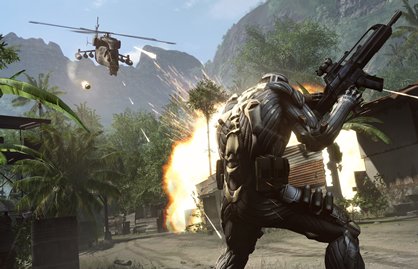Developer commentary: Crysis
We turn on stealth mode and creep into Crytek HQ
Seeing as they’re so adept at (justified) high-end technological willy-waving, it’s interesting to discover that in person the gents who make up Crytek are some of the most polite, interesting and decent human beings in the entirety of the games industry. Always honest and philosophical about their achievements, our interview with them on the creation of the gameplay marvel that was Crysis was so open and so interesting that we’ve granted it extra room. The men interviewed were senior game designer Bernd Diemer and lead level designer Sten Hubler.
Suited and booted
Bernd: “The original design for the nanosuit was actually something different, back when we had our working title ‘Paradise’. We had an upgrade system that started you as a normal soldier in his uniform, and as you went through the first half of the game you got upgrades to the suit, to fight the aliens with. We tried to incorporate that into the design, but we found that it didn’t work out too well because it was more of a role-playing thing. After preproduction though, we decided to give all the stuff to the player right from the start, and that’s when we really started thinking about the nanosuit as essential - a core feature of the game.”

Mano a mano
Bernd: “The inspiration was the 2020 Future Warrior project, which nearly every army on earth is working on. They’re not looking to create superheroes, but to make people move faster and act stronger. From that we took it a bit towards the edge, more towards sci-fi. We wanted somebody who could do cool stuff but never an outright superhero who could fly or be far beyond human enemies. We wanted to give people more choice in encounters, and so we came up with this three power system, so you could go into a situation and think ‘Hey, maybe I’ll cloak here,’ jump on top of something or whatever.”
Nano Rejects
Bernd: “We had this device, which allowed you to adjust the external temperature of the cloak to match the environment. We took that out because it was so complicated to work - fiddling with the dials. In the end we used a more digital system: you’re either cloaked, or you’re not. At one time, anything we thought was cool we’d try - even our version of bullet-time. We had a prototype but, even though it was really cool, it was just one of those things you just have to do right - if we have a superpower in the game it has to be something we’re comfortable with. So we thought ‘No, no. We’ll stick with what we have, and put it in the drawer with all our other fancy ideas.’ We may take one or two out in the future.”

Beware branch monster
Bernd: “From the start we wanted to have this completely open world in which you have the freedom to even kill story characters, but then we got to the problem that every project like this has, that we can’t tell the story if a story character is dead. It turns into something we nowadays call ‘The Branch Monster,’ because when you cut one thing, there’ll be another head growing. The most important thing in the end was the production value, and the story itself, so we decided to focus on a more traditional storytelling method - you want to make people care about characters in the story, and having them killable is counterproductive to that. So now, if you were near the beginning with Psycho and he said ‘Bollocks’, and you accidentally dropped a grenade and killed him, you wouldn’t be without him for the rest of the game. It’s a lot better to have this character develop alongside the player than delivering an incredibly complex open-ended project.”
Grab chicken, throw at rock
Bernd: “Little Animals. Always my favourite. People just take such a lot of pleasure in killing animals! Grabbing animals and throwing them around, or just throwing discarded ovens at North Koreans. Well, the grabbing character thing was one of the great moments we had in development, because when we started it - it was pretty stiff. We spoke about it, and thought that you should be able to grab every object in the game, but we didn’t really think that people would want to grab enemies and throw them around. At the beginning we didn’t even know this was possible. Later, we did a focus test, and one of the first things we noticed was that people would try and sneak up to the Koreans and grab them. But you couldn’t! So we just thought ‘Oh shit! Looks like we have to put that in as well.’ We spoke to the programmers and everybody said ‘No, we couldn’t do that, it’s impossible. It’ll destroy the game.’ But one of the programmers did it on his own and was able to present a prototype that was so well implemented that it proved it was doable. It still had a lot of problems, but we dealt with them. It’s great that we got it through. No matter what it cost, we had to do it.”
Weekly digests, tales from the communities you love, and more


